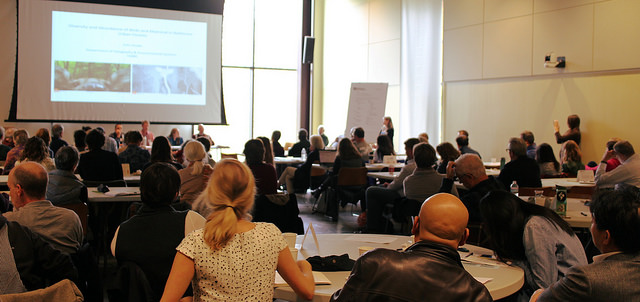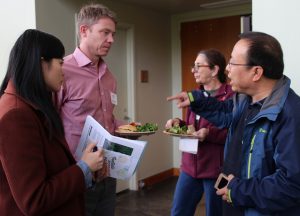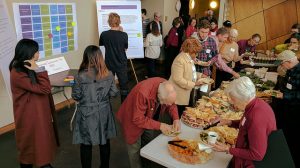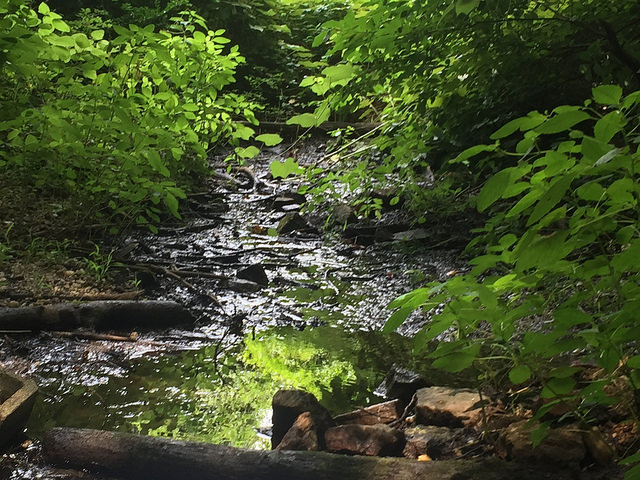
By Abby Rammelkamp
It wasn’t news to the crowd at the Fantastic Forests Forum in November: forests are fantastic. One-hundred-twenty scientists, forest stewards and other community members, and staff from nonprofits and government agencies as far away as New York City and China joined Baltimore Green Space to hear about Baltimore’s community forests.
For five years, Baltimore Green Space has supported residents who care for community forest patches. We’ve also spearheaded the research that established forest patches as an important part of Baltimore’s tree canopy. The Forest Forum, held at Cylburn Arboretum’s Vollmer Center, was our opportunity to showcase the community and scientific work that’s been happening in Baltimore’s woods, and we couldn’t have been more pleased by the turnout and enthusiasm.
The Forum also let us get input from knowledgeable, passionate folks for our Forest Prioritization, which will help us identify good sites for preservation, maintenance, and research. Participants also discussed strategies to encourage forest preservation.
So, what did people learn? During the session “The Scientists Speak,” scientists discussed their research on the soil, plants, animals, and environmental effects of Baltimore’s urban forest patches.
Dr. Matt Baker kicked us off with a presentation touching on the differences between the plant communities found at the edges and interior of the forest patches. He was followed by Ian Yesilonis, a soil scientist with the USDA Forest Service who has been very involved with Baltimore Green Space’s forest work. Yesilonis explained the role of a forest’s duff layer. Duff, which lies just over the soil, should be a thick, spongy layer of decomposed plant materials. A healthy duff layer promotes the growth of a wide variety of plants and absorbs storm runoff. Unfortunately, earthworms, which are not native to North America, eat the duff layer, changing which plants can thrive. City forest soils aren’t ideal because we have worms – but they are far better than even the scientists expected.

Dr. Anne Hairston-Strang, Associate Director of Statewide Programs in the Maryland Department of Natural Resources, studies the science behind forest buffers – the trees, shrubs, and other plants that grow next to streams and rivers. She pointed out that urban forest patches moderate the water cycle; the deep rooting of the trees and the soil’s litter layer absorb water. Forest soil organisms enable the soil to absorb more runoff and reduce its nitrogen content.
Anna Scott, a PhD candidate at Johns Hopkins in Earth and Planetary Science, studies the capacity of trees to cool cities. She is collecting data at sites throughout Baltimore City to compare the air temperature of those with grass, plants, trees, or forest patches to those covered in pavement. She told us that when it comes to cooling, grass is good, trees are better, and urban forest patch is best.
Birds and animals find a home in Baltimore’s forest patches, as animal ecologist Dr. Colin Studds explained. Studds, of UMBC’s Geography and Environmental Systems Department, studies factors that make animal populations rise and fall. His research in Baltimore found eight mammal species in Baltimore’s forest patches. He noted that white-tailed deer are extremely destructive because they strip the plants at eye level and below, prevent new trees from being established, change forest structure, and shut out certain mammals. The more deer, the fewer foxes. The foxes aerate the soil and have nitrogen-rich urine. Dr. Studds mentioned a couple of ways to get rid of deer, such as professional archers and deer fencing.

The session “The People Speak” looked at the social side of forest patches. Nancy Sonti, a PhD candidate at the University of Maryland, talked about her research on how neighbors perceive the forest patches. While few go into the patches, most appreciate the forests’ presence. One neighbor said, “I love watching the wildlife. I don’t mind seeing Miss Foxy walk up and down the sidewalk.”
But the highlight of the day was hearing from the neighborhood residents who care enough about their neighborhoods to take on the role of forest steward for their local forests. With support and resources from Baltimore Green Space, they have educated themselves about good forest management practice, and have reached out to their neighbors to teach them the benefits of their community forests and to get more help in the woods. Helene Perry of the Govans Urban Forest, Charles Brown of the Winston Park Woods, and Butch Berry of Springfield Woods all told of reclaiming neglected land from invasive vines and dumped mattresses. Volunteers from local schools and universities helped with the clean up.
The stewards also noted obstacles to clearing and reclaiming the forests: Helene would like a place to put the trash, Charles fights the English ivy that kills the trees, and Butch would like to see more community members get involved. Nevertheless, people spend time in the woods when they used to avoid these patches of land, and children learn and play there. As Dr. Morgan Grove, the Team Leader for the USDA Forest Service Northern Research Station, pointed out, what inspires children to grow up to be forest scientists isn’t the big national forest parks, but the trees in their neighborhood.
Many thanks to our sponsors, the USDA Forest Service, the Chesapeake Bay Trust, and the Cylburn Arboretum Association, and to the wonderful volunteers from the Baltimore City Forestry Board.

Be the first to hear about exciting events, news, and opportunities.
[email protected]
(813) 530-8166
2100 Liberty Heights Avenue
Baltimore MD 21217
Facebook | Instagram | Twitter